#Oenochoe
Photo
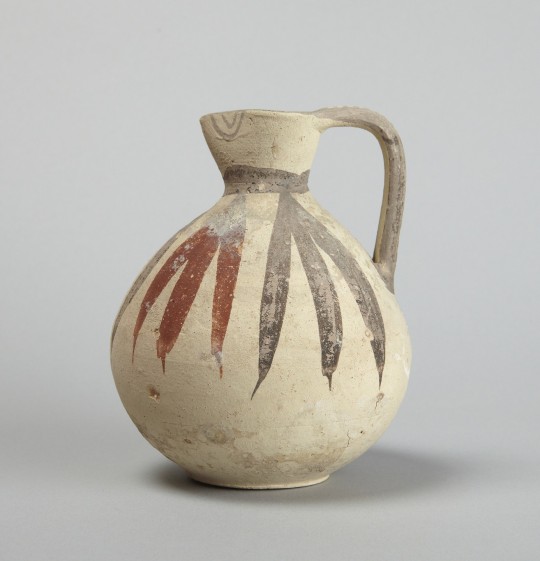
Oenochoe (Bichrome V Ware), 600–475 B.C./ Cypro-Archaic II / Cypriote
10 notes
·
View notes
Text
exgirlfriends big ass
Party Girls Show Pussy To Crowd While Dancing
Blonde angel screaming from fuck by long thick black dick in ass
JERK OFF CHALLENGE CHRISTINA AGUILERA . (SEX SOUND, METRONOME)
Boy anal gay sex movie xxx Deacon is the next in line to use and the
Couples enjoys after honeymoon
Plowed cfnm teen creamed
Cleveland thot giving sloppy toppy
Skinny blonde dildo masturbation
College Girl Orgasm on me
#Messidor#Uaraycu#thorps#noncorrelating#Ketu#tost#tresses#Periclean#disinsulation#oenochoe#match#isleless#roomless#amphigam#ramilies#Farleigh#hyperdiazeuxis#adenographical#morphic#meningismus
0 notes
Text

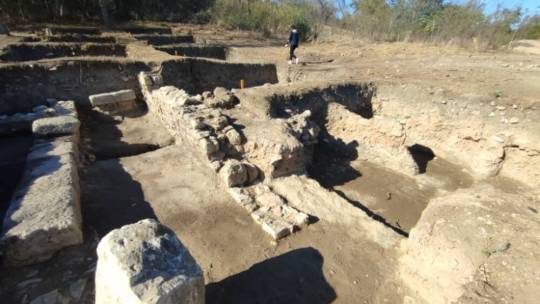
Archaeologists Discovered Roman Floor Mosaics in Bulgaria
Archaeologists discovered floor mosaics with early Christian designs and nearly 800 artifacts in the archaeological reserve of Marcianopolis in Devnya, in the northeastern part of Bulgaria.
The Roman town of Marcianopolis (present-day Devnya) in northeastern Bulgaria appears to have originated as a Thracian settlement. It was later inhabited by Hellenized settlers from Asia Minor and named Parthenopolis.

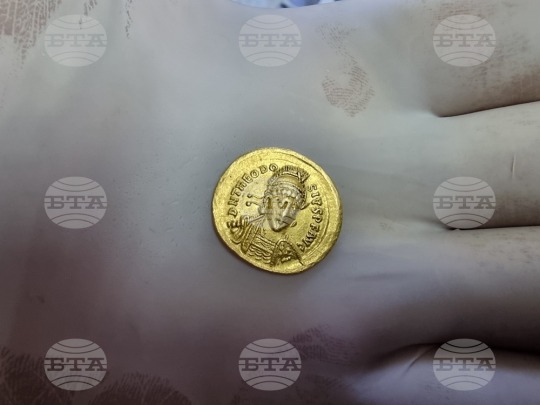
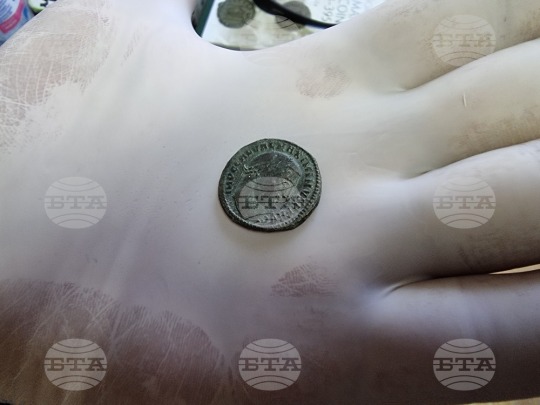
Roman Marcianopolis was established around 106 CE, following Trajan’s campaigns in Dacia to the north. The settlement was named after his sister, Ulpia Marciana. At the crossroads between Odessos (modern Varna), Durostorum, and Nicopolis ad Istrum, as well as the location of plentiful springs, Marcianopolis became a strategically important settlement.
Diocletian’s administrative reforms in the late third century CE divided Moesia Inferior into Moesia Secunda and Scythia Minor, with Marcianopolis serving as the former’s administrative capital. Marcianopolis experienced its most prosperous period during the middle of the fourth century CE. From 367 CE to 369 CE, the eastern emperor Valens used Marcianopolis as his winter quarters during campaigns against Visigoth incursions in the region. During this time, it served as the Eastern Empire’s temporary capital.

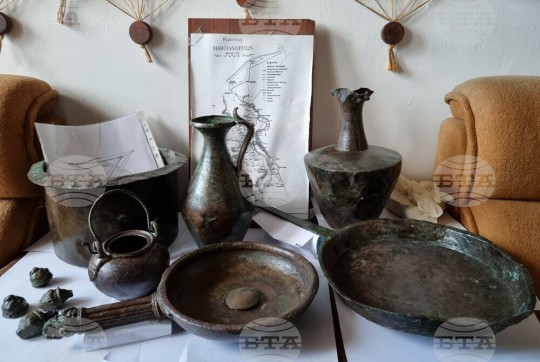

Floor mosaics with early Christian designs were found in the remains of a building. Archaeologists are not yet sure whether it was a public building or it belonged to a rich Roman citizen.
The tentative dating of the mosaics is in the first half of the 4th century AD.
The finds from the current archaeological season in Devnya contain another thousand bronze coins, several clay lamps and two clay vessels, which are awaiting scientific processing and restoration.
During the past archeological season, researchers restored bronze vessels discovered in the 1990s in a brick-walled tomb dating to the late 2nd – early 3rd century.
The vessels had a ritual use and were related to the personality of the person buried, Mosaic Museum director Ivan Sutev said in a statement to BTA.


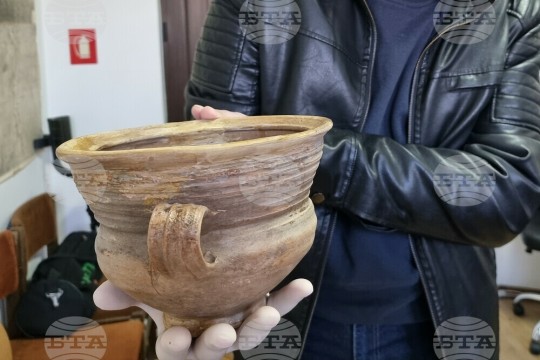

They are richly decorated and the workmanship is exquisite, he added. The find includes a vessel for pouring liquids as offering to a deity, and a wine jug with a trefoil mouth (oenochoe). A simple kitchen pan was also found along with these. All this leads archaeologists to suggest that a Roman citizen of Marcianopolis may have been laid to rest in the tomb, but that he may have had more specific functions: a soldier, a cook, or even a priest, Sutev said.
Pottery that was discovered in the basilica’s environs during excavations in 2023 has since been restored. Among these are a mortarium vessel for liquids and an exquisite crater-shaped pot for liquids. These were located in the structure with the mosaic floors. Coins from the time of Emperor Theodosius II were also found scattered on the floor.
In 447, Attila’s Huns captured and destroyed Marcionopolis after conquering the entire Balkan Peninsula but failing to capture Constantinople. That is determined by 20 gold coins scattered on the floor of the building being studied. On one side of the coins is an image of Theodosius II, while on the other is the patron goddess of Constantinople. Among the coins discovered during the Marcianopolis excavations were those from the city’s founding in the second century. The latter are dated to the sixth century, around the time of Emperor Justinian.
By Oguz Buyukyildirim.
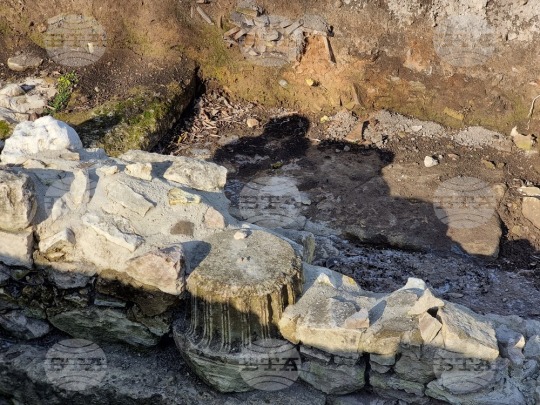
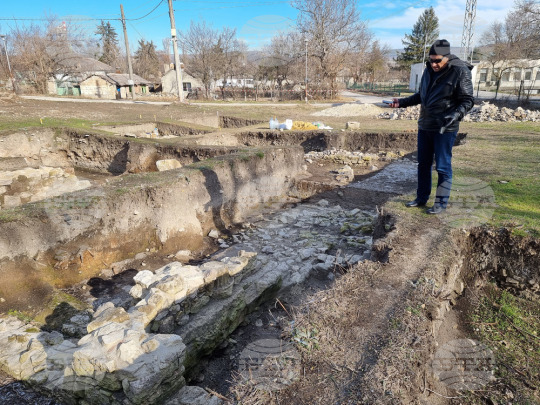
#Archaeologists Discovered Roman Floor Mosaics in Bulgaria#The Roman town of Marcianopolis#gold#gold coins#roman gold coins#ancient artifacts#archeology#archeolgst#history#history news#ancient history#ancient culture#ancient civilizations#roman history#roman empire#roman art#Emperor Theodosius II
44 notes
·
View notes
Text
Pelagio Palagi, 1775/1860 Sappho and Rhodope
The ancient Greek poet Sappho lived in the 7th and 6th centuries BC. BC, at Mytilene on the island of Lesbos.

Known for having expressed in her poems her attraction to women, hence the term "sapphism" to designate female homosexuality, often confused with the term "lesbian" derived from Lesbos, the island where she lived.
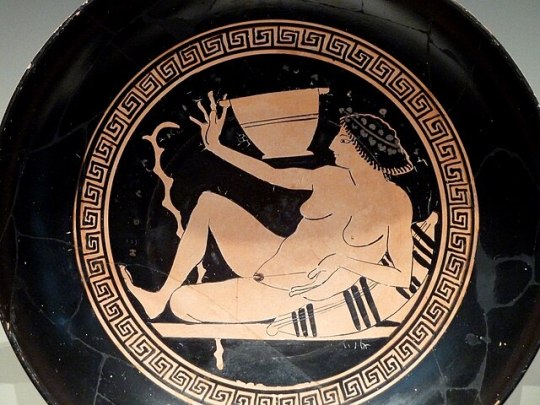
Rhodope is a hetaera, an educated woman of high social standing who offers her companionship and/or sexual services. A sort of courtesan, she is our modern “escort-girl”.
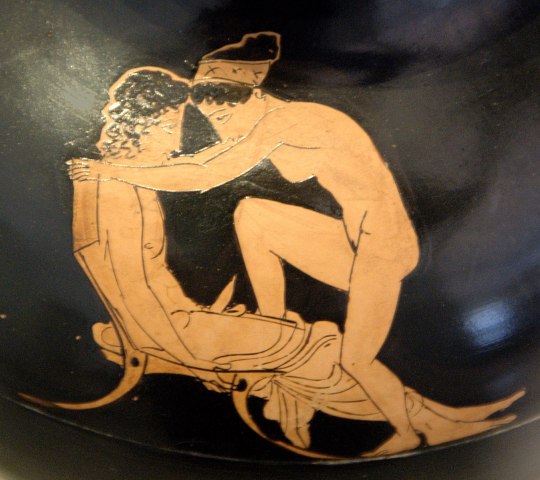
A young hetaera and a young man making love on an Attic red-figure oenochoe by the painter Shuválov, circa 430 BC. Chr.,
2 notes
·
View notes
Text
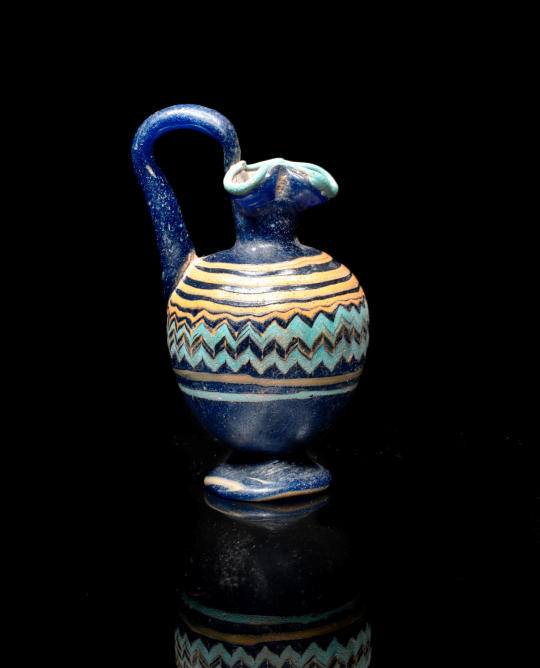


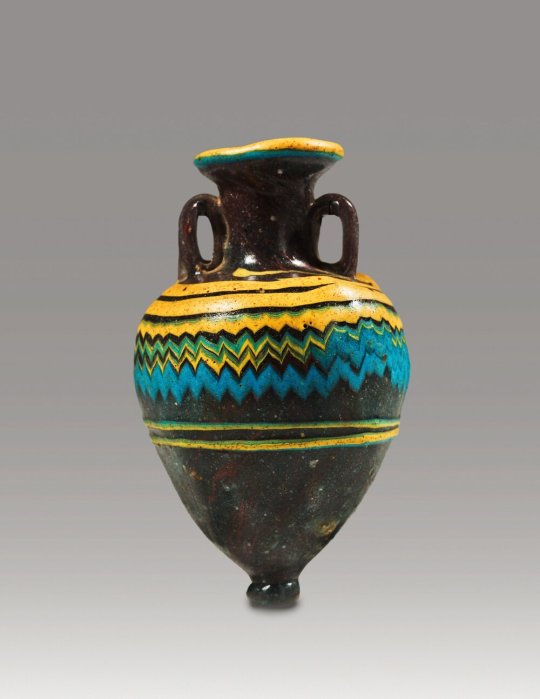
Ancient Mediterranean core-formed glass vessels.
Oenochoe (wine jug), c. mid 6th-4th century BCE
Aryballos (perfume bottle), c. late 6th-5th century BCE
Oenochoe (wine jug), c. late 6th-5th century BCE
Amphoriskos (container for oil), c. late 6th-early 5th century BCE
4 notes
·
View notes
Photo
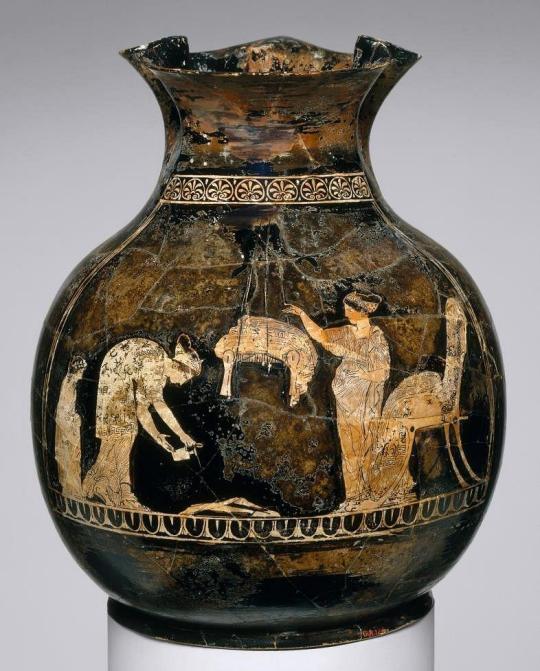
MWW Artwork of the Day (8/3/22)
Attributed to the Meidias Painter (Greek, fl. late 5th c. BCE)
Women Perfuming Clothes (c. 420-410 BCE)
Terracotta red-figure oinochoe, 21.4 x 17.9 cm.
The Metropolitan Museum of Art, New York (Gift of Samuel G. Ward)
An oenochoe (also spelt oinochoe) is a wine jug and a key form of Greek pottery. The scene depicts two women in festive dress perfuming garments. A stool suspended by chords is piled with folded clothing. On the ground below, there is a pile of wood shavings and twigs from which smoke rises. One woman carefully empties an oinochoe onto the fire. The other woman surveys the "swing" and stands beside a stately chair with a footstool over which more clothes are slung. At the far left is a wreathed boy wearing a himation (cloak). The shape of the vase facilitates the association of the scene with the Anthesteria, a three-day festival held in January/February that celebrated the new wine with the special inclusion of young children, an epiphany of Dionysos, and the ritual marriage of the god with the basilinna, the wife of the chief archon of Athens.
For more Ancient Greek pottery, visit this MWW Special Collection:
https://www.facebook.com/media/set/?vanity=TheMuseumWithoutWalls&set=a.419770264795015
14 notes
·
View notes
Text
5th century athens tumblr dashboard simulator
💪🏻 theoeikelos because you follow #athenian politics
just a reminder in advance of ostracism season: i know themistocles might not be your first choice to exile (he sure isnt mine!) but being realistic, the only people who have a chance of winning are themistocles and aristides. if you vote for some random guy you hate or write in a joke, thats as good as voting for aristides and we cant take that risk. please please please vote themistocles
#athenian politics #themistocles #aristides
98 notes

🍇 symposiarch
hey guys should i go knock the penises of the herms i think it would be really funny
🌌 your-fave-is-aeolic follow
this is probably the unmixed wine talking but yes, yes you should
🏛 generation-of-leaves follow
It makes me so sad to see how this website glorifies impiety against the city and the gods. I have hope that you will find your way back to timē.
🍇 symposiarch
lmao i always forget there's a cult of hermes side of tumblr
97 notes

🐢 aspiringchoregos
guys ive been looking at that most tragic character poll and honestly i think that the antigone side is using bots to vote. the vote count is going up by 100 every few seconds, who even likes antigone?? all i remember about that play is that my teacher made me write prosopopoeiae based on it
#also its just suspicious to see so many antigone votes on the new music enjoyers website #choregos shut up
2 notes

🏺 kallias-art-blog follow
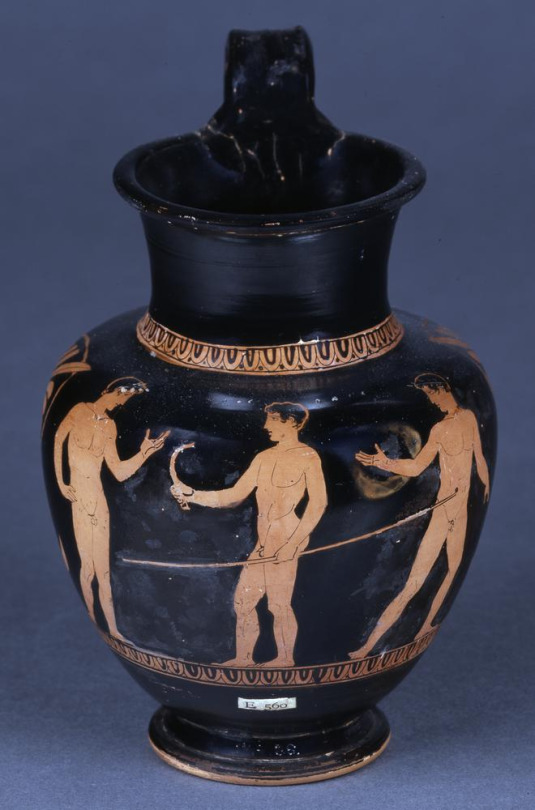
finally finished painting this today, im really happy with how it turned out!
like all my other projects, this is for sale at my etsy store! support metic artists :)
#art #artistsontumblr #redfigure #vasepainting #oenochoe #my art
572 notes

👁 most-tragic-character-agon follow

😝 asexual-oedipus
reblogging again because we can not let antigone lose to a character best known from a fucking EURIPIDES play! medea isnt even that tragic she's just evil
#tragedy agon #antigone
2377 notes

🏳️🌈 harmodogeiton
i keep getting s*cratics following me so i guess i havent been clear enough on here: i do not support oligarchy, terrorism, or corrupting the youth and if you do then i kindly suggest that you unfollow me and also go to the fucking crows
15 notes

🐝 bucolic-aesthetic

#sicily #lilybaeum #bucolic #bucolic aesthetic #shepherd aesthetic #selinous #magna graecia #apoikia
609 notes

🔱 piercedbyeros follow
i call my dick the thesmophoria because it's abundant in seed and only for the women
🍇 symposiarch
i call my dick the panathenaea because i parade it through the acropolis
🆕 post-store
1 hemitetartemorion
#tagamemnon#dashboard simulator#ancient greece#there are SO many other things that classical athenians could post about#i didnt even make any posts from people complaining about their democracy jobs or long orations or asclepius#im proud of asexual-oedipus as a url#the hall of fame
10K notes
·
View notes
Photo
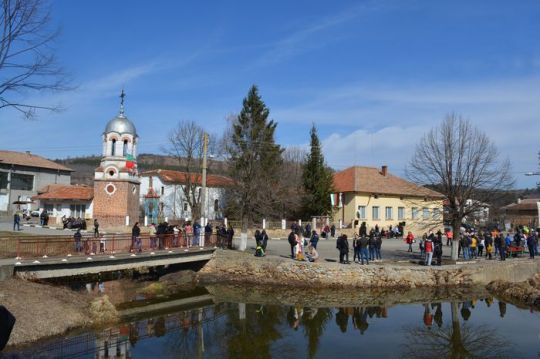
Marble statue of Ephebus
Staircase {down) on the Wall.—Large bas-relief of a Thracian horseman from Salonica, 3rd cent. B.c.
BOOM HO. 20.—Marble statues and friezes of Boman period from Aphrodisias.
BOOM NO. 21.—On entering: A marble statue of Ephebus standing, from Tralles. This is one of the finest marble statues of the Museum, and it belongs to the Hellenistic art, i.e., about the 3rd cent. B.c. On the right: Archaic statues. On the left: Statues of the Hellenistic period. Head of Alexander the Great from Cos. Head of Alexander the Great (part of the nose broken) from Pergamos. Bust of Apollo from Tralles, 3rd cent. B.c. This statue was not cut out of a single block, but consisted originally of six pieces held together by clamps.
BOOM NO. 22.—On the right: Statues of the Greco-Roman period. On the left of the Roman period: Statue of Hadrian from Crete, and representing the Emperor standing and trampling on the figure of a child representing Cyrenaica Yicta. Statue of Nero from Tralles.
ROOM NO. 23,OR BYZANTINE HALL.—(On the floor) large mosaic from Syria discovered by Prof. H. Butler of Princeton University. Also several other marble objects of the early Christian period.
ROOM NO. 24.—Marble statues of Roman period.
ROOM NO. 25.—Assyrian statues.
Archaic statue of Hercules
ROOM NO. 26, OR HERCULES ROOM.—Archaic statue of Hercules from Cyprus represented as killing a Ron. Also Assyrian statues.
ROOM NO. 27.—Various funereal steles, mostly from tombs in Asia Minor.
ROOM NO. 1
The sarcophagus called the Satrap’s, No. 18, was unearthed at Saida in 1887 by Hamdi Bey and his party. It is of Paros marble, and was originally painted; traces of blue are still visible on one of its faces, the rest of the colouring having been effaced, and the carvings themselves much worn, by the action of the water which filled the chamber of the catacomb in which it was discovered. One of the comers of the trough and lid was unfortunately broken off during the excavating operations, but the fragments have now been pieced together again.
This sarcophagus, in its general aspect, represents a Greek temple. The trough is in the form of a truncated pyramid, and is anthropoid inside; the bottom is adorned with a row of rais de cceur, and the top with a row of pearls and ovulae; on the sides are four sculptured panels in a framing of carved palm-leaves.
The head or northern panel, represents a funeral banquet. The corpse is depicted laid out on a bier, and is evidently that of some Oriental potentate or satrap, with a long beard and hair bound with a head-band, and clad in long flowing robes. Its left hand grasps a goblet, while its right holds a rhyton, and is extended towards a female figure in a long tunic and with hair confined by a head- band, who stands in front of him in the act of replenishing the rhyton from an oenochoe. Behind the woman is another seated on a chair, and with part of her himcdion drawn over her head, while yet another female figure is depicted towards the satrap’s right.
0 notes
Photo
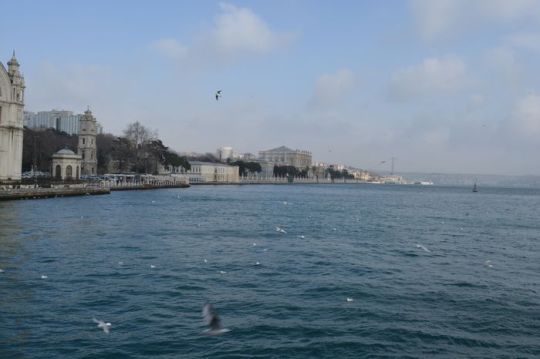
Marble statue of Ephebus
Staircase {down) on the Wall.—Large bas-relief of a Thracian horseman from Salonica, 3rd cent. B.c.
BOOM HO. 20.—Marble statues and friezes of Boman period from Aphrodisias.
BOOM NO. 21.—On entering: A marble statue of Ephebus standing, from Tralles. This is one of the finest marble statues of the Museum, and it belongs to the Hellenistic art, i.e., about the 3rd cent. B.c. On the right: Archaic statues. On the left: Statues of the Hellenistic period. Head of Alexander the Great from Cos. Head of Alexander the Great (part of the nose broken) from Pergamos. Bust of Apollo from Tralles, 3rd cent. B.c. This statue was not cut out of a single block, but consisted originally of six pieces held together by clamps.
BOOM NO. 22.—On the right: Statues of the Greco-Roman period. On the left of the Roman period: Statue of Hadrian from Crete, and representing the Emperor standing and trampling on the figure of a child representing Cyrenaica Yicta. Statue of Nero from Tralles.
ROOM NO. 23,OR BYZANTINE HALL.—(On the floor) large mosaic from Syria discovered by Prof. H. Butler of Princeton University. Also several other marble objects of the early Christian period.
ROOM NO. 24.—Marble statues of Roman period.
ROOM NO. 25.—Assyrian statues.
Archaic statue of Hercules
ROOM NO. 26, OR HERCULES ROOM.—Archaic statue of Hercules from Cyprus represented as killing a Ron. Also Assyrian statues.
ROOM NO. 27.—Various funereal steles, mostly from tombs in Asia Minor.
ROOM NO. 1
The sarcophagus called the Satrap’s, No. 18, was unearthed at Saida in 1887 by Hamdi Bey and his party. It is of Paros marble, and was originally painted; traces of blue are still visible on one of its faces, the rest of the colouring having been effaced, and the carvings themselves much worn, by the action of the water which filled the chamber of the catacomb in which it was discovered. One of the comers of the trough and lid was unfortunately broken off during the excavating operations, but the fragments have now been pieced together again.
This sarcophagus, in its general aspect, represents a Greek temple. The trough is in the form of a truncated pyramid, and is anthropoid inside; the bottom is adorned with a row of rais de cceur, and the top with a row of pearls and ovulae; on the sides are four sculptured panels in a framing of carved palm-leaves.
The head or northern panel, represents a funeral banquet. The corpse is depicted laid out on a bier, and is evidently that of some Oriental potentate or satrap, with a long beard and hair bound with a head-band, and clad in long flowing robes. Its left hand grasps a goblet, while its right holds a rhyton, and is extended towards a female figure in a long tunic and with hair confined by a head- band, who stands in front of him in the act of replenishing the rhyton from an oenochoe. Behind the woman is another seated on a chair, and with part of her himcdion drawn over her head, while yet another female figure is depicted towards the satrap’s right.
0 notes
Photo

Marble statue of Ephebus
Staircase {down) on the Wall.—Large bas-relief of a Thracian horseman from Salonica, 3rd cent. B.c.
BOOM HO. 20.—Marble statues and friezes of Boman period from Aphrodisias.
BOOM NO. 21.—On entering: A marble statue of Ephebus standing, from Tralles. This is one of the finest marble statues of the Museum, and it belongs to the Hellenistic art, i.e., about the 3rd cent. B.c. On the right: Archaic statues. On the left: Statues of the Hellenistic period. Head of Alexander the Great from Cos. Head of Alexander the Great (part of the nose broken) from Pergamos. Bust of Apollo from Tralles, 3rd cent. B.c. This statue was not cut out of a single block, but consisted originally of six pieces held together by clamps.
BOOM NO. 22.—On the right: Statues of the Greco-Roman period. On the left of the Roman period: Statue of Hadrian from Crete, and representing the Emperor standing and trampling on the figure of a child representing Cyrenaica Yicta. Statue of Nero from Tralles.
ROOM NO. 23,OR BYZANTINE HALL.—(On the floor) large mosaic from Syria discovered by Prof. H. Butler of Princeton University. Also several other marble objects of the early Christian period.
ROOM NO. 24.—Marble statues of Roman period.
ROOM NO. 25.—Assyrian statues.
Archaic statue of Hercules
ROOM NO. 26, OR HERCULES ROOM.—Archaic statue of Hercules from Cyprus represented as killing a Ron. Also Assyrian statues.
ROOM NO. 27.—Various funereal steles, mostly from tombs in Asia Minor.
ROOM NO. 1
The sarcophagus called the Satrap’s, No. 18, was unearthed at Saida in 1887 by Hamdi Bey and his party. It is of Paros marble, and was originally painted; traces of blue are still visible on one of its faces, the rest of the colouring having been effaced, and the carvings themselves much worn, by the action of the water which filled the chamber of the catacomb in which it was discovered. One of the comers of the trough and lid was unfortunately broken off during the excavating operations, but the fragments have now been pieced together again.
This sarcophagus, in its general aspect, represents a Greek temple. The trough is in the form of a truncated pyramid, and is anthropoid inside; the bottom is adorned with a row of rais de cceur, and the top with a row of pearls and ovulae; on the sides are four sculptured panels in a framing of carved palm-leaves.
The head or northern panel, represents a funeral banquet. The corpse is depicted laid out on a bier, and is evidently that of some Oriental potentate or satrap, with a long beard and hair bound with a head-band, and clad in long flowing robes. Its left hand grasps a goblet, while its right holds a rhyton, and is extended towards a female figure in a long tunic and with hair confined by a head- band, who stands in front of him in the act of replenishing the rhyton from an oenochoe. Behind the woman is another seated on a chair, and with part of her himcdion drawn over her head, while yet another female figure is depicted towards the satrap’s right.
0 notes
Photo

Marble statue of Ephebus
Staircase {down) on the Wall.—Large bas-relief of a Thracian horseman from Salonica, 3rd cent. B.c.
BOOM HO. 20.—Marble statues and friezes of Boman period from Aphrodisias.
BOOM NO. 21.—On entering: A marble statue of Ephebus standing, from Tralles. This is one of the finest marble statues of the Museum, and it belongs to the Hellenistic art, i.e., about the 3rd cent. B.c. On the right: Archaic statues. On the left: Statues of the Hellenistic period. Head of Alexander the Great from Cos. Head of Alexander the Great (part of the nose broken) from Pergamos. Bust of Apollo from Tralles, 3rd cent. B.c. This statue was not cut out of a single block, but consisted originally of six pieces held together by clamps.
BOOM NO. 22.—On the right: Statues of the Greco-Roman period. On the left of the Roman period: Statue of Hadrian from Crete, and representing the Emperor standing and trampling on the figure of a child representing Cyrenaica Yicta. Statue of Nero from Tralles.
ROOM NO. 23,OR BYZANTINE HALL.—(On the floor) large mosaic from Syria discovered by Prof. H. Butler of Princeton University. Also several other marble objects of the early Christian period.
ROOM NO. 24.—Marble statues of Roman period.
ROOM NO. 25.—Assyrian statues.
Archaic statue of Hercules
ROOM NO. 26, OR HERCULES ROOM.—Archaic statue of Hercules from Cyprus represented as killing a Ron. Also Assyrian statues.
ROOM NO. 27.—Various funereal steles, mostly from tombs in Asia Minor.
ROOM NO. 1
The sarcophagus called the Satrap’s, No. 18, was unearthed at Saida in 1887 by Hamdi Bey and his party. It is of Paros marble, and was originally painted; traces of blue are still visible on one of its faces, the rest of the colouring having been effaced, and the carvings themselves much worn, by the action of the water which filled the chamber of the catacomb in which it was discovered. One of the comers of the trough and lid was unfortunately broken off during the excavating operations, but the fragments have now been pieced together again.
This sarcophagus, in its general aspect, represents a Greek temple. The trough is in the form of a truncated pyramid, and is anthropoid inside; the bottom is adorned with a row of rais de cceur, and the top with a row of pearls and ovulae; on the sides are four sculptured panels in a framing of carved palm-leaves.
The head or northern panel, represents a funeral banquet. The corpse is depicted laid out on a bier, and is evidently that of some Oriental potentate or satrap, with a long beard and hair bound with a head-band, and clad in long flowing robes. Its left hand grasps a goblet, while its right holds a rhyton, and is extended towards a female figure in a long tunic and with hair confined by a head- band, who stands in front of him in the act of replenishing the rhyton from an oenochoe. Behind the woman is another seated on a chair, and with part of her himcdion drawn over her head, while yet another female figure is depicted towards the satrap’s right.
0 notes
Text
Belly Amphora Ajax And Achilles Playing A Game | Apulian Red Figure Pelike | Ancient Greek Vase Replicas For Sale | High Quality Custom Replica Impressionism Oil Painting |
Ancient Greek Vase Replicas For Sale
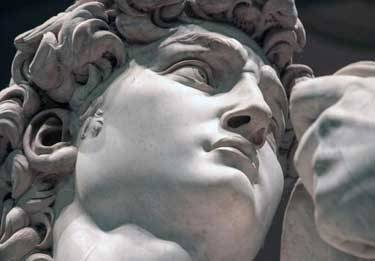
Attic red-figure hydria-kalpis (vase for transporting water) decorated with a scene depicting soldiers marching forth to fight. A young family member, possibly the warrior's sister or wife, is depicted on the right side of the composition, holding an oenochoe with a trefoil-mouthed oenochoe and poised to perform a libation
#Ancient Greek Vase Replicas For Sale#High Quality Custom Oil Painting Replicas#Museum Qualith Replicas#High Quality Custom Replica Impressionism Oil Painting
0 notes
Text
“Artemis could, and did, as sculptures of Artemis Ephesia prove, exist as the seemingly paradoxical virginal mother, representing care and nurturing femininity in a context completely removed from questions of sexuality. Different from all of these, however, are Running Artemis and Artemis Fastening Her Mantle. Running Artemis, an original Greek marble dated between the late 2nd century BC and the 1st century AD, has come down through the centuries in pieces, and only the torso to the knee joints remain, currently in the collection of the Saint Louis Art Museum (fig. 5). Despite the apparent paucity of the sculpture’s complete form, what is left offers more than enough information about how the sculptor sought to portray Artemis’s femininity. Originally running, as the name suggests, the stumps of the arms and legs suggest a wide range of motion. The quiver strap which still separates and underlines her breast suggests that possibly she held a bow, though her pose and action beyond running are unclear. Above all this, however, it is the drapery, or rather, its defiance of normal conventions of fabric, is what begs notice. Despite being carved in stone, the fabric of Artemis’s short chiton seems as delicate and thin as tissue paper. The ripples and folds of the fabric cascade across her figure more like water than anything else, barely concealing the flesh that they cover. Her nipples and areolae are almost visible, her belly-button is clear as day, as is much of the toning on her stomach, and her legs stand out almost perfectly. Her genital region is only spared this treatment by a cleverly placed undulation in the fabric. The combination of garment and form exudes a subtle sexuality – one that, in the context of depictions of a virgin goddess, is nearly unbelievable. As heroic nudity emphasized masculinity, clothing, too, could be used to emphasize feminine form and beauty.31 This treatment of fabric and form, wherein the body is “covered with a tunic of thin material clinging close to the forms – wetted drapery” revealing almost everything, is accepted and common on depictions of nymphs, nereids, and Aphrodite, to name a few, but rarely so with Artemis.32 Even so, some sculptors did seek to portray Artemis as physically desirable, as Artemis Fastening Her Mantle supports.
Associated with Praxiteles, this work is also known as the Diana of Gabii, and has been called “one of the most attractive works of ancient art” by viewers of it at its current home in the Louvre (fig. 6).33 While it is again a Roman copy after a Greek 4th century BCE original, the statement can hardly be argued. Fully intact, this vision of Artemis presents her in a more sedate and domesticated moment as she fastens part of her clothing about her shoulder. The curve of her neck and shoulders is revealed as her hair is bound upon her head by a fillet. Again she wears the short chiton, but this time it slips artfully and somewhat tantalizingly off her shoulder, revealing just enough flesh of the breast to make the viewer wonder what more there is. Delicately she twists her arm, holding the closure of her mantle, or himation, between the thumb and forefingers in a way that allows the rest of her fingers to fan out in a graceful arc. There is a sense that this moment is private, that the viewer is intruding on a moment of readying for the day. Absent are the bow and quiver. In this moment, Artemis is desirable, elegant, and comely, posed identically to Aphrodite on Athenian red-figure oenochoe, attributed to Polion or the Heimarmene Painter and currently in the collection of the Vatican (fig 7).34 These two sculptures prove that, to some sculptors, Artemis’s “virginity is not asexual like that of Athena, but is highly sexualized,” as a maiden before marriage is considered ripe for the picking.35 Rather than emphasizing Artemis’s power, prowess, or divinity, they emphasize her form and her delicacy, adhering to an ideal that places women in the confines of the home.36 As many have observe, “Artemis’s virginity … seems to invite violation,” her wildness, domestication.37 Rapes, both attempted and successful, are all too common in myths of Artemis, and often extend to her followers.38 While in mythology these incidents are regarded as a “heinous assault” punishable by justly horrible death, sculptors faced no such dangers.39 Just as Homer infantilized Artemis on the battlefields of Troy and portrayed her as a mewling weakling in the face of Hera’s tirades, these artists remove her sexual agency, devaluing her choice of eternal virginity by making her an object to be visually consumed for pleasure..”
- Laura G. Waters, Artemis: Depictions of Form and Femininity in Sculpture
0 notes
Photo

Odysseus listens to the song of the Sirens. Attic black-figure oenochoe, artist unknown; ca. 525-500 BCE. Now in the Altes Museum, Berlin. Photo credit: Carole Raddato.
#classics#tagamemnon#Ancient Greece#Archaic Greece#classical mythology#Odysseus#Odyssey#The Odyssey#Sirens#art#art history#ancient art#Greek art#Ancient Greek art#Archaic Greek art#black-figure#vase painting#oinochoe#oenochoe#Altes Museum
132 notes
·
View notes
Photo
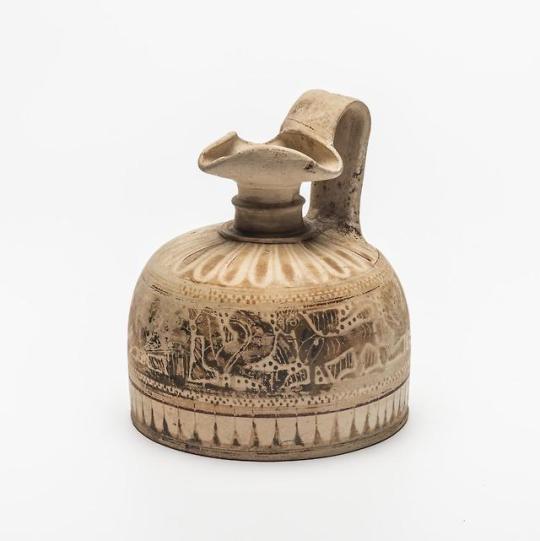
Oenochoe
Place: Ancient Greece, Corinth
Date: Circa 570- 550 BC
Material: yellowish clay, brown lacquer, purple paint
The State Hermitage Museum
35 notes
·
View notes
Text
Greek oenochoe

ITEM
Oenochoe
MATERIAL
Bronze
CULTURE
Greek
PERIOD
4th - 2nd Century B.C
DIMENSIONS
210 mm x 150 mm
CONDITION
Damaged
PROVENANCE
Ex Dutch private collection, acquired between 1960 - 1980
Read the full article
#ancient#ancientart#ancienthistory#antiquity#artefact#artifact#ancientartifacts#antiquities#art#artobject#ancientgreece#ancientworld#history#classical#archaeology#greek#bronze#vessel#oenochoe
0 notes